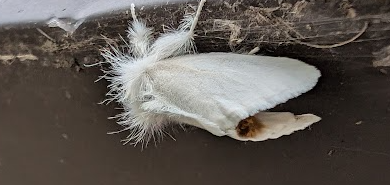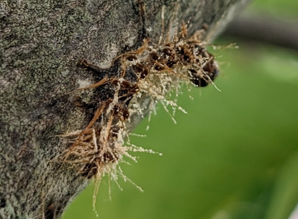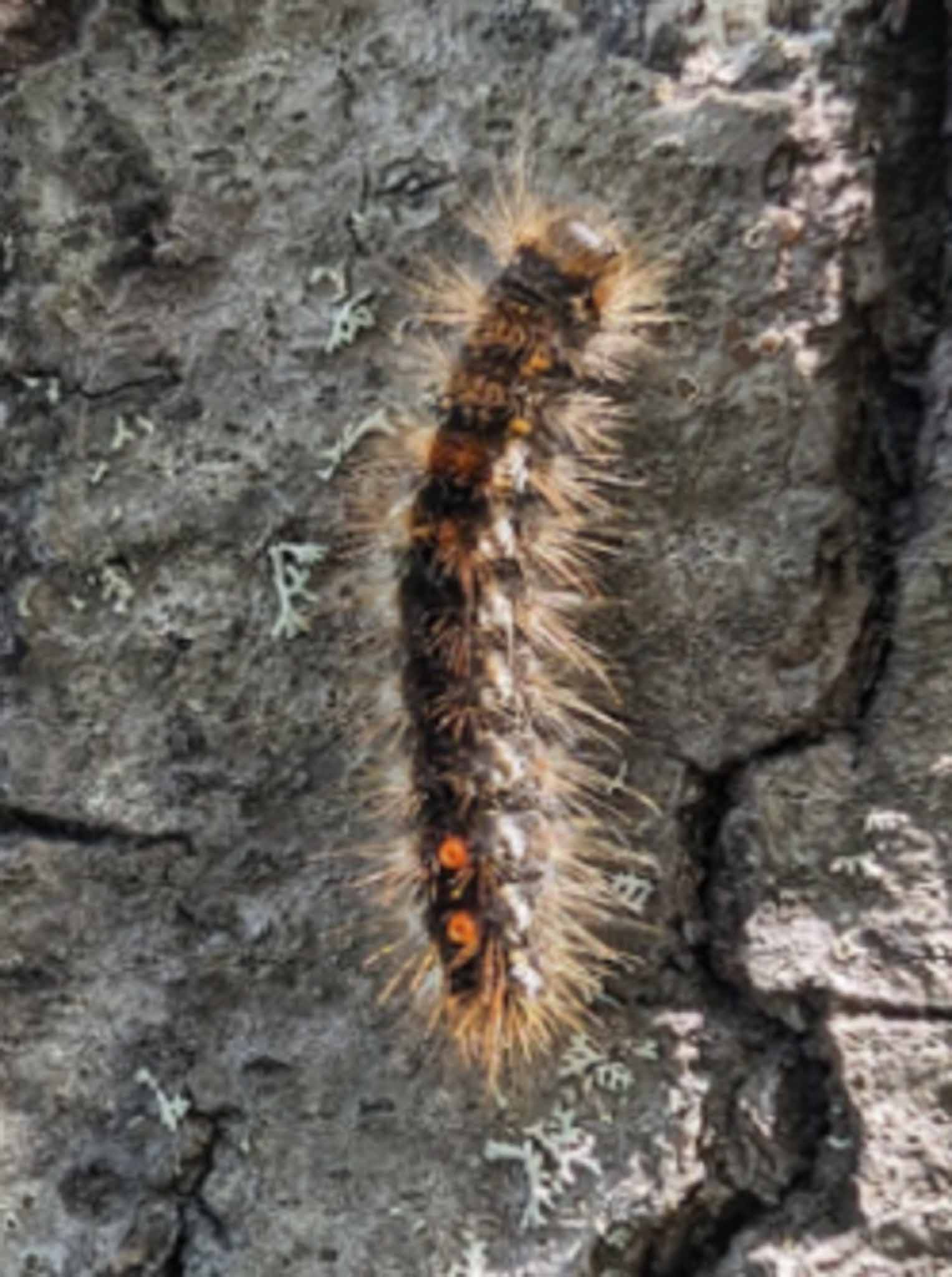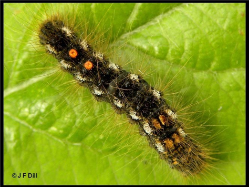Browntail Moth Response
July 31, 2024:
Staff have been monitoring areas in Bangor where adult moths have gathered in the past. These are all areas where lights are on during the overnight hours. In July 2023, we observed hundreds of adult browntail moths in these locations. This year we counted fewer than a dozen moths in all locations, combined. This includes our observation locations on public and private property.

Adult browntail moth (credit Public Works, 7/9/24)
We have contacted a Maine Forest Service entomologist and found that many places around the state are reporting lower adult moth populations, though not all. They mentioned that there was an early hatch of adult moths in some areas of the state, suggesting that we may have missed them, but we have been watching for them since they went into cocoon - we don’t think we missed anything. Further supporting our observations, there has been a marked decrease in adult moth reporting from residents this year. Last year we received 17 reports of adult moths gathering around lights during the month of July. This year we received only one report.
As we mentioned in our July 10 update, we witnessed widespread signs of the entomophaga aulicae fungus during June and early July. We also saw limited evidence of parasitic wasps that kill caterpillars. Our theory is that weather conditions were perfect for the natural enemies of the BTM to effectively reduce the population in the City.
What does this mean for BTM in Bangor? While we don’t have a crystal ball that will tell us the future, we believe the lack of adults must mean there will be fewer breeding pairs of adult moths. Fewer breeding pairs should mean fewer egg masses. We will be watching for the hatch, to get a feel for the population that will bother us next year, but the tiny caterpillars can be hard to spot and evidence of their feeding is skeletonized leaves, which aren’t always easy to spot if the population is small. The real evidence will come in the late fall/early winter when the caterpillars gather into their winter webs. We will be doing surveys throughout the City during the ’24-’25 winter season to count BTM winter webs. This will be our true indicator of next year’s population.
In the meantime, please be aware that the BTM caterpillar cocoons still contain toxic hairs, even if the caterpillars inside were killed by fungus or wasp. Wind and rain can break down these cocoons, releasing the hairs into the environment. Toxic BTM hairs are likely still in the soil, too, where they can retain their ability to cause rashes for up to three years.
Keep an eye on this page for future updates on our battle against the browntail moth. You can also monitor the State of Maine Forest Service webpage for statewide updates.
If you see adult browntail moths, you can report them through our SeeClickFix reporting system, or through the SeeClickFix app that can be downloaded from Google Play or the Apple App Store. Your reports help inform our efforts to fight the browntail moth infestation in Bangor!
July 10, 2024:
Adult browntail moths have started to emerge from their cocoons in the City of Bangor. We have received a single resident report from the West side of the City and two were also sighted under an outside light at Public Works. Note the namesake brown tail, barely visible, under the wings.

Credit: City of Bangor Public Works, 7/9/24
Please report your moth sightings through our SeeClickFix Bangor webpage or app, Submit a Service Request (bangormaine.gov). These sighting reports help us track the infestation in the City and also help us target our efforts to mitigate the effects of BTM on the public.
The weather this year ended up being a great incubator for the entomophaga aulicae fungus that is fatal to caterpillars. We spotted the fungus on browntail moth and eastern tent caterpillars in June. We hope this fungus helped reduce the BTM population, though there isn’t an easy way to quantify it. We will be watching moth numbers to see if there is a noticeable difference in quantity this year.
Attracting these moths to your property will increase the chances of hosting a new generation of browntail moths. To avoid this, the Maine Forest Service is recommending you take the following steps:
• Turn off unnecessary outside lights at night. Lights attract the male moths and where there is a gathering of male moths, the females gather in the surrounding trees waiting to mate. They are especially active from 9:00 pm – midnight, so this is a critical time to have your lights turned off.
• If you must have a light on, try switching to a yellow bulb. Research by Dr. Angela Mech, at the University of Maine, indicates the moths are more attracted to white and blue light, less attracted to yellow light.
• Avoid social media advice regarding the creation of light traps. These will kill moths but will attract many more that will not get caught and will mate in the trees surrounding your property.
If you find you have BTM gathering on the walls around your outside lights, you can vacuum them into a wet/dry vac that has soapy water inside, to drown them. If they are out of reach, you can spray them down with a hose, then vacuum them up.
Please exercise caution when cleaning up the moths. The hairs of the adult moth are not toxic. However, the moths just emerged from a cocoon where their old caterpillar hairs were shed. These hairs may stick to the moth and become airborne. Additionally, the cocoons have now been broken open and windy days can open them further, resulting in more airborne hairs. While the active caterpillar season has passed, we urge residents to continue to take precautions against exposure.
We realize the City of Bangor has streetlights all over and they stay on all night. Many of these are adjacent resident properties. These are on for safety and will continue to stay on. However, we have recently completed our streetlight conversion to LED lights. These fixtures have the ability to be upgraded to more intelligent light management options. We are actively researching a City-wide lighting plan that will also explore the cost and benefits of intelligent light controls.
The Maine Forest Service has an incredible compilation of information about the BTM and site-specific information from all over the State of Maine. There, you can read their latest update, as well as links to other important information: Browntail Moth Euproctis chrysorrhoea : Forest Health & Monitoring: Bureau of Forestry: Maine DACF
June 12, 2024:
Browntail moth caterpillars have been busy gorging themselves on new leaves and have been molting skins as they go. Now that they have reached their full size, observations around the City indicate that the majority of BTM caterpillars have gone into cocoon stage. To do this, they pull leaves together, as shown in the picture below, to make a safe place and spin their cocoon web inside this shelter.

Credit: Bangor Public Works, Waterfront Park
These caterpillars will develop into moths over the next several weeks, emerging in July as white moths. Please continue to be aware of the risks presented by the toxic hairs of the BTM. These hairs can release toxins for up to three years. As the caterpillars grew larger, they shed hairs, releasing them into the environment where winds can pick them up and carry them a considerable distance.
Last year I mentioned that we saw evidence of the entomophaga aulicae fungus that kills caterpillars. We are seeing even more of this fungus this year! The Maine Forest Service says that conditions are better this year because we are getting a little rain and a little warm, sunny weather. The sunny breaks allow the fungus to effectively release spores and multiply, where straight rainy weather does not. Public Works staff found this fungus had killed off caterpillars at multiple monitoring sites around the City.

Credit: Bangor Public Works, East Side
In addition to the fungus, one staff member saw a wasp that looked very much like a parasitoid wasp that also attacks caterpillars. Unfortunately, they were unable to get a picture. the wasp was landing exclusively on BTM cocoons so that may have been a good sign. These natural enemies of the BTM are our best bet for a large-scale collapse of the BTM population in Maine. Let’s cheer on these tiny heroes!
In the meantime, please be vigilant in protecting yourselves and your loved ones. As the moths emerge in July, they will leave behind cocoons containing their old bodies, including the toxic hairs that will be released and become airborne on windy days or when you perform activities that stir them up. Try to mow and rake when the ground is damp to minimize the hairs that get airborne. Wear clothing that covers the body. Shorts and t-shirt are great for enjoying the nice weather but not for raking, mowing, or using the string trimmer. If you do suspect that you have been exposed to the hairs, try to wash them off with cool, soapy water, and change your clothes as the hairs may work their way through the cloth onto your skin.
May 22, 2024:
Young browntail moth caterpillars (BTM) have been very active the last three weeks. Up until this week, they were moving out of their winter nests each morning and returning each night. Many residents may have seen them hanging from silk strands on trees. This week they appear to have left their nests for good and are eating voraciously. All the eating helps them grow very fast. As they grow, they molt (shed their skins) and each successive molting results in more toxicity in their hairs. Unfortunately, this means residents will start experiencing more frequent reactions to the toxic hairs as they become airborne.

Photo taken on treated tree at Public Works yard 5/21/24
We can expect this active molting and hair shedding to take place through the end of June. Last year we were seeing caterpillars moving into cocoon stage the third week of June, but the timing varies from year to year.
This is the time of year to be extremely vigilant about protecting yourself, and those you love, from the effects of these tiny toxic hairs. If you observe caterpillars with the telltale orange dots in the trees where you are working or recreating, take precautions to protect yourself. While it may be inconvenient, and sometimes impossible, the best way to avoid exposure to the hairs is to leave the area where the BTM caterpillars are present. If you must occupy an area with a strong browntail moth caterpillar population, try to protect yourself by covering exposed skin. Plan your work for early mornings with a heavy dew or after a rain. Rain and dew will moisten the hairs and make it much harder for them to become airborne. Avoid mowing, digging, and raking when ground conditions are really dry or if the wind is blowing BTM hairs out of trees. When you are done working, remove your clothing and wash it separately from other clothes. Immediately wash all exposed skin with cool, soapy water to remove the hairs before they can get into your pores.
If you cannot wash immediately after exposure, we have found that IVY-X wipes (a disposable wipe designed to remove poison ivy sap from skin) help remove the hairs in the field. If you do end up with the rash, local pharmacies carry compounded mixtures that work well to relieve the itching. There are also many recipes available online to make your own mixtures.
As for the trial applications of pesticide in City parks, it is a bit early to see definitive results. We have definitely seen live BT caterpillars in treated trees. Each tree takes up and spreads the pesticide at a different rate so it may still be moving out to the leaves that the caterpillars are eating. We will continue to monitor the results to help us determine the next steps in our browntail moth reaction plan.
Public Works Director Aaron Huotari photographed a caterpillar that appeared to have died from the naturally occurring fungus that attacks BTM. This spring, the rainy, then sunny conditions have provided favorable conditions for this fungus. The hope is that the fungus spreads and attacks the BTM population on a large scale.
May 1, 2024:
We have been watching browntail moth nests in Bangor. We are seeing a lot of activity inside the nests, but haven’t seen them feeding, just yet. We expect them to be exiting the nests any time now (see photo below).

Courtesy B. Schappach, Maine Forest Service
For those of you who clipped winter webs, or hired a contactor to clip nests on your property – Congratulations! You have taken a very important step to create a better environment around your home. For those of you who were unable to do any winter web clipping, you still have an option. Licensed pesticide applicators can treat your trees with an injection that will target the caterpillars who feed voraciously as they exit the nests. The State of Maine Department of Agriculture, Conservation & Forestry maintains a list of licensed applicators willing to treat BTM on their website, List of Licensed Pesticide Applicators Willing to Treat Browntail Moth and/or Hemlock Woolly Adelgid: Browntail Moth (Euproctis chrysorrhoea): Forest Health & Monitoring: Bureau of Forestry: Maine DACF.
The Parks & Recreation Department is continuing their trial injections of trees infected with BTM. Parks are areas specifically designated for public recreation so they are a logical place to try and reduce the BTM population, creating a safer place for the public to congregate. The City injected 20 trees in 6 City parks last year. These parks were chosen based on public reports of BTM. Infested trees were injected with one of two pesticides to test for effectiveness. Trees were then observed through the season and were inspected for winter webs in February.
Based on our BTM winter web observations, we have selected 31 trees for injection of one type of pesticide in the following parks:
- Broadway Park 6 trees
- Coe Park 11 trees
- Davenport Park 2 trees
- Fairmount Park 9 trees
- Old Cemetery Park 2 trees
- Talbot Park 1 tree
The goal is to create a safe, healthy environment in areas where people gather and recreate. Residents should look at this the same way. Collectively, we will never clip enough nests or inject enough trees to eradicate BTM – regardless of the time, effort, or money is thrown at the problem. Your goal should be to make efforts to improve your situation. Residents should continue to report BTM through our Service Request system at Request for Service - City of Bangor, ME (bangormaine.gov). Those reports help inform our efforts in public areas, like I described above. Your work to clip BTM nests on your property or have your trees injected can improve your yard. Working together, we can have a positive impact on the areas we inhabit.
Despite all our efforts, the BTM will still be out there. Remember to be watching for them telltale orange spots on the back of the caterpillar (see photo below). When you see them, take precautions to prevent exposure to the hairs. The best way to avoid exposure to the hairs is to leave the area where the BTM caterpillars are present. We understand that this isn’t always possible, though. If you must do work in an area with a strong BTM presence, try to cover as much exposed skin as possible. Plan your work for early mornings with a heavy dew or after a rain. Rain and dew will moisten the hairs and make it much harder for them to become airborne. Avoid mowing, digging, and raking when ground conditions are really dry or if the wind is blowing BTM hairs out of trees. When you are done working, remove your clothing and wash it separately from other clothes. Immediately wash all exposed skin with cool, soapy water to remove the hairs before they can get into your pores. If you cannot wash immediately after exposure, we have found that IVY-X wipes (a disposable wipe designed to remove poison ivy sap from skin) help remove the hairs in the field. We have also heard that using the sticky side of duct tape to lift the hairs off your skin (dab or blot the tape on your skin to grab the hairs) can help to limit exposure. If you do end up with the rash, local pharmacies carry compounded mixtures that work well to relieve the itching.
Lastly, I want to point out that the Maine Forest Service has an excellent website to inform the public about the BTM problem in Maine, Browntail Moth Euproctis chrysorrhoea : Forest Health & Monitoring: Bureau of Forestry: Maine DACF. Remember that Southern Maine has seen the BTM problem for many more years than we have and much of the Maine Forest Service information is based on their experiences there.

Courtesy JF Dill, Maine Cooperative Extension
February 20, 2024:
The City of Bangor Public Works Forestry Division conducted an educational event to help residents and businesses in Bangor recognize and remove browntail moth (BTM) nests. One of the least environmentally impactful ways to mitigate a BTM infestation in the spring is to remove the winter nests while the caterpillars are dormant. Each nest removed in the winter months eliminates up to 400 BTM caterpillars in the spring. These caterpillars present a health risk for residents due to the toxic hairs they shed while growing. Attendees had an opportunity to watch a demonstration and then use the pole pruners. Learn about the pole pruner loan program here.
February 1, 2024:
The City of Bangor Public Works Forestry Division demonstrates how to properly trim browntail moth nests from trees and dispose of them.
Browntail moth overviews:
Health Concerns
The browntail moth caterpillar has tiny poisonous hairs that cause dermatitis similar to poison ivy on sensitive individuals. People may develop dermatitis from direct contact with the caterpillar or indirectly from contact with airborne hairs.
The hairs become airborne from either being dislodged from the living or dead caterpillar or they come from cast skins with the caterpillar molts. Most people affected by the hairs develop a localized rash that will last for a few hours up to
several days but on some sensitive individuals the rash can be severe and last for several weeks. The rash results from both a chemical reaction to a toxin in the hairs and a physical irritation as the barbed hairs become embedded in the skin.
What are the symptoms of browntail moth toxin exposure?
-
A skin rash on any part of your body that was exposed. The rash tends to be red, bumpy, and itchy.
-
Respiratory issues such as breathing difficulty can occur if the browntail moth hairs are inhaled.
-
If you are having trouble breathing, swallowing, or swelling of your mouth, tongue, or throat, call 9-1-1.
How do I treat the rash?
According to the Maine CDC, mild rashes can be treated at home with:
-
A cool bath with baking soda or Aveeno Oatmeal Bath
-
Hydrocortisone cream, such as Cortaid, applied sparingly to the itchiest areas
-
Calamine or caladryl lotion
-
If home remedies are not working, see your healthcare provider. There are medications that your healthcare provider might recommend.
-
Be careful not to apply any creams or lotions to places where young children may rub them into their eyes or mouth.
Is the rash contagious?
You cannot "catch" the rash from another person like you can a cold. The hairs need to come in contact with your skin, mouth, throat, or respiratory tract for symptoms to appear.
Learn more about the Browntail Moth:
Maine Department of Agriculture, Conservation & Forestry's website
Maine CDC Browntail Moth fact sheet